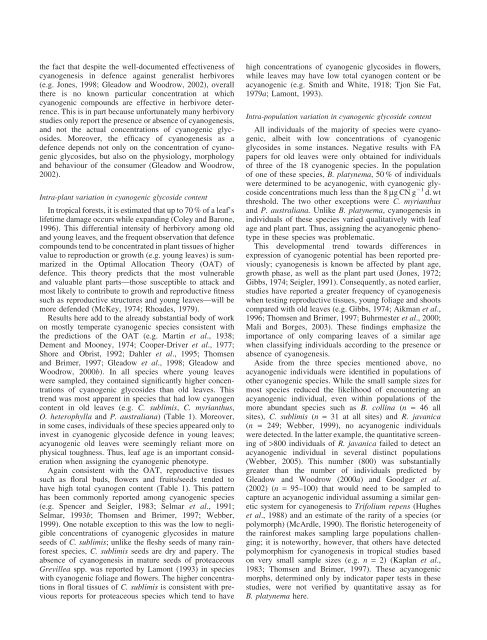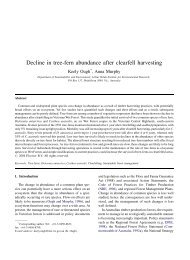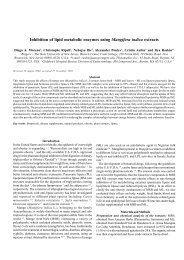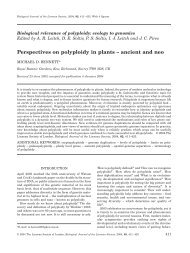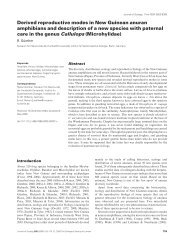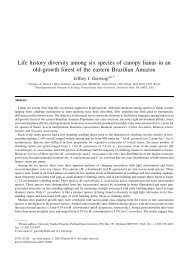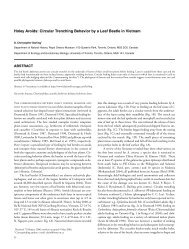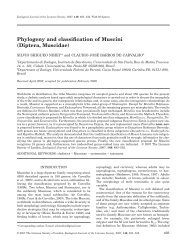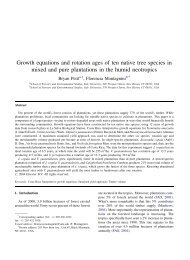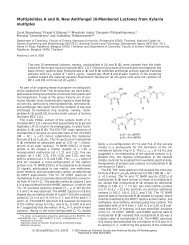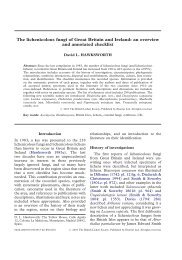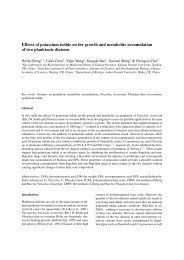Frequency of Cyanogenesis in Tropical Rainforests of Far North ...
Frequency of Cyanogenesis in Tropical Rainforests of Far North ...
Frequency of Cyanogenesis in Tropical Rainforests of Far North ...
Create successful ePaper yourself
Turn your PDF publications into a flip-book with our unique Google optimized e-Paper software.
the fact that despite the well-documented effectiveness <strong>of</strong><br />
cyanogenesis <strong>in</strong> defence aga<strong>in</strong>st generalist herbivores<br />
(e.g. Jones, 1998; Gleadow and Woodrow, 2002), overall<br />
there is no known particular concentration at which<br />
cyanogenic compounds are effective <strong>in</strong> herbivore deterrence.<br />
This is <strong>in</strong> part because unfortunately many herbivory<br />
studies only report the presence or absence <strong>of</strong> cyanogenesis,<br />
and not the actual concentrations <strong>of</strong> cyanogenic glycosides.<br />
Moreover, the efficacy <strong>of</strong> cyanogenesis as a<br />
defence depends not only on the concentration <strong>of</strong> cyanogenic<br />
glycosides, but also on the physiology, morphology<br />
and behaviour <strong>of</strong> the consumer (Gleadow and Woodrow,<br />
2002).<br />
Intra-plant variation <strong>in</strong> cyanogenic glycoside content<br />
In tropical forests, it is estimated that up to 70 % <strong>of</strong> a leaf’s<br />
lifetime damage occurs while expand<strong>in</strong>g (Coley and Barone,<br />
1996). This differential <strong>in</strong>tensity <strong>of</strong> herbivory among old<br />
and young leaves, and the frequent observation that defence<br />
compounds tend to be concentrated <strong>in</strong> plant tissues <strong>of</strong> higher<br />
value to reproduction or growth (e.g. young leaves) is summarized<br />
<strong>in</strong> the Optimal Allocation Theory (OAT) <strong>of</strong><br />
defence. This theory predicts that the most vulnerable<br />
and valuable plant parts—those susceptible to attack and<br />
most likely to contribute to growth and reproductive fitness<br />
such as reproductive structures and young leaves—will be<br />
more defended (McKey, 1974; Rhoades, 1979).<br />
Results here add to the already substantial body <strong>of</strong> work<br />
on mostly temperate cyanogenic species consistent with<br />
the predictions <strong>of</strong> the OAT (e.g. Mart<strong>in</strong> et al., 1938;<br />
Dement and Mooney, 1974; Cooper-Driver et al., 1977;<br />
Shore and Obrist, 1992; Dahler et al., 1995; Thomsen<br />
and Brimer, 1997; Gleadow et al., 1998; Gleadow and<br />
Woodrow, 2000b). In all species where young leaves<br />
were sampled, they conta<strong>in</strong>ed significantly higher concentrations<br />
<strong>of</strong> cyanogenic glycosides than old leaves. This<br />
trend was most apparent <strong>in</strong> species that had low cyanogen<br />
content <strong>in</strong> old leaves (e.g. C. sublimis, C. myrianthus,<br />
O. heterophylla and P. australiana) (Table 1). Moreover,<br />
<strong>in</strong> some cases, <strong>in</strong>dividuals <strong>of</strong> these species appeared only to<br />
<strong>in</strong>vest <strong>in</strong> cyanogenic glycoside defence <strong>in</strong> young leaves;<br />
acyanogenic old leaves were seem<strong>in</strong>gly reliant more on<br />
physical toughness. Thus, leaf age is an important consideration<br />
when assign<strong>in</strong>g the cyanogenic phenotype.<br />
Aga<strong>in</strong> consistent with the OAT, reproductive tissues<br />
such as floral buds, flowers and fruits/seeds tended to<br />
have high total cyanogen content (Table 1). This pattern<br />
has been commonly reported among cyanogenic species<br />
(e.g. Spencer and Seigler, 1983; Selmar et al., 1991;<br />
Selmar, 1993b; Thomsen and Brimer, 1997; Webber,<br />
1999). One notable exception to this was the low to negligible<br />
concentrations <strong>of</strong> cyanogenic glycosides <strong>in</strong> mature<br />
seeds <strong>of</strong> C. sublimis; unlike the fleshy seeds <strong>of</strong> many ra<strong>in</strong>forest<br />
species, C. sublimis seeds are dry and papery. The<br />
absence <strong>of</strong> cyanogenesis <strong>in</strong> mature seeds <strong>of</strong> proteaceous<br />
Grevillea spp. was reported by Lamont (1993) <strong>in</strong> species<br />
with cyanogenic foliage and flowers. The higher concentrations<br />
<strong>in</strong> floral tissues <strong>of</strong> C. sublimis is consistent with previous<br />
reports for proteaceous species which tend to have<br />
high concentrations <strong>of</strong> cyanogenic glycosides <strong>in</strong> flowers,<br />
while leaves may have low total cyanogen content or be<br />
acyanogenic (e.g. Smith and White, 1918; Tjon Sie Fat,<br />
1979a; Lamont, 1993).<br />
Intra-population variation <strong>in</strong> cyanogenic glycoside content<br />
All <strong>in</strong>dividuals <strong>of</strong> the majority <strong>of</strong> species were cyanogenic,<br />
albeit with low concentrations <strong>of</strong> cyanogenic<br />
glycosides <strong>in</strong> some <strong>in</strong>stances. Negative results with FA<br />
papers for old leaves were only obta<strong>in</strong>ed for <strong>in</strong>dividuals<br />
<strong>of</strong> three <strong>of</strong> the 18 cyanogenic species. In the population<br />
<strong>of</strong> one <strong>of</strong> these species, B. platynema, 50 % <strong>of</strong> <strong>in</strong>dividuals<br />
were determ<strong>in</strong>ed to be acyanogenic, with cyanogenic glycoside<br />
concentrations much less than the 8 mgCNg 1 d. wt<br />
threshold. The two other exceptions were C. myrianthus<br />
and P. australiana. Unlike B. platynema, cyanogenesis <strong>in</strong><br />
<strong>in</strong>dividuals <strong>of</strong> these species varied qualitatively with leaf<br />
age and plant part. Thus, assign<strong>in</strong>g the acyanogenic phenotype<br />
<strong>in</strong> these species was problematic.<br />
This developmental trend towards differences <strong>in</strong><br />
expression <strong>of</strong> cyanogenic potential has been reported previously;<br />
cyanogenesis is known be affected by plant age,<br />
growth phase, as well as the plant part used (Jones, 1972;<br />
Gibbs, 1974; Seigler, 1991). Consequently, as noted earlier,<br />
studies have reported a greater frequency <strong>of</strong> cyanogenesis<br />
when test<strong>in</strong>g reproductive tissues, young foliage and shoots<br />
compared with old leaves (e.g. Gibbs, 1974; Aikman et al.,<br />
1996; Thomsen and Brimer, 1997; Buhrmester et al., 2000;<br />
Mali and Borges, 2003). These f<strong>in</strong>d<strong>in</strong>gs emphasize the<br />
importance <strong>of</strong> only compar<strong>in</strong>g leaves <strong>of</strong> a similar age<br />
when classify<strong>in</strong>g <strong>in</strong>dividuals accord<strong>in</strong>g to the presence or<br />
absence <strong>of</strong> cyanogenesis.<br />
Aside from the three species mentioned above, no<br />
acyanogenic <strong>in</strong>dividuals were identified <strong>in</strong> populations <strong>of</strong><br />
other cyanogenic species. While the small sample sizes for<br />
most species reduced the likelihood <strong>of</strong> encounter<strong>in</strong>g an<br />
acyanogenic <strong>in</strong>dividual, even with<strong>in</strong> populations <strong>of</strong> the<br />
more abundant species such as B. coll<strong>in</strong>a (n = 46 all<br />
sites), C. sublimis (n = 31 at all sites) and R. javanica<br />
(n = 249; Webber, 1999), no acyanogenic <strong>in</strong>dividuals<br />
were detected. In the latter example, the quantitative screen<strong>in</strong>g<br />
<strong>of</strong> >800 <strong>in</strong>dividuals <strong>of</strong> R. javanica failed to detect an<br />
acyanogenic <strong>in</strong>dividual <strong>in</strong> several dist<strong>in</strong>ct populations<br />
(Webber, 2005). This number (800) was substantially<br />
greater than the number <strong>of</strong> <strong>in</strong>dividuals predicted by<br />
Gleadow and Woodrow (2000a) and Goodger et al.<br />
(2002) (n = 95–100) that would need to be sampled to<br />
capture an acyanogenic <strong>in</strong>dividual assum<strong>in</strong>g a similar genetic<br />
system for cyanogenesis to Trifolium repens (Hughes<br />
et al., 1988) and an estimate <strong>of</strong> the rarity <strong>of</strong> a species (or<br />
polymorph) (McArdle, 1990). The floristic heterogeneity <strong>of</strong><br />
the ra<strong>in</strong>forest makes sampl<strong>in</strong>g large populations challeng<strong>in</strong>g;<br />
it is noteworthy, however, that others have detected<br />
polymorphism for cyanogenesis <strong>in</strong> tropical studies based<br />
on very small sample sizes (e.g. n = 2) (Kaplan et al.,<br />
1983; Thomsen and Brimer, 1997). These acyanogenic<br />
morphs, determ<strong>in</strong>ed only by <strong>in</strong>dicator paper tests <strong>in</strong> these<br />
studies, were not verified by quantitative assay as for<br />
B. platynema here.


